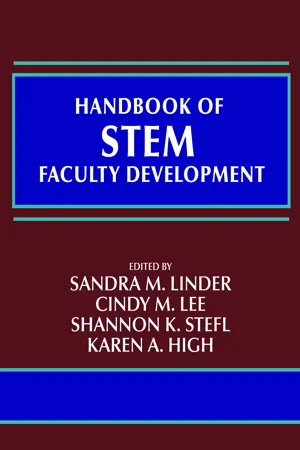
Handbook of STEM Faculty Development
- English
- PDF
- Available on iOS & Android
Handbook of STEM Faculty Development
About this book
Faculty in the science, technology, engineering, and mathematics (STEM) disciplines face intensifying pressures in the 21st century, including multiple roles as educator, researcher, and entrepreneur. In addition to continuously increasing teaching and service expectations, faculty are engaged in substantive research that requires securing external funding, mentoring other faculty and graduate students, and disseminating this work in a broad range of scholarly outlets. Societal needs of their expertise include discovery, innovation, and workforce development. It is critical to provide STEM faculty with the professional development to support their complex roles and to base this development on evidence derived from research. This edited handbook provides STEM stakeholders with an opportunity to share studies and/or experiences that explore STEM faculty development (FD) in higher education settings. More specifically, we include work that examines faculty development planning, techniques/models, experiences, and outcomes focused on supporting the teaching, research, service, and leadership responsibilities of STEM faculty. The Handbook is suited for researchers and practitioners in STEM, STEM Education, Mathematics, Science, Technology, and Engineering disciplines. It is also suited towards faculty developers, higher education administrators, funding agencies, industry leaders, and the STEM community at large.This handbook is organized around three constructs (INPUTS, MECHANISMS, and OUTPUTS). The STEM faculty development inputs construct focuses on topics related to the characteristics of faculty members and institutions that serve as barriers or supports to the adoption and implementation of holistic STEM faculty development programs. Questions addressed in the handbook around this topic include: What barriers/supports exist for STEM faculty? How are these barriers/supports being addressed through STEM FD? How do contexts (e.g., economic, political, historical) influence faculty/administrative needs related to STEM FD? How do demographics (e.g., gender, ethnicity, age, family background) influence faculty/administrative needs related to STEM FD? The STEM faculty development mechanisms construct focuses on topics related to the actual implementation of STEM faculty development and we consider the potential models or structures of STEM faculty development that are currently in place or conceptualized in theory. Questions addressed in the handbook around this topic include: What are the processes for developing models of STEM FD? What are effective models of STEM FD? How is effectiveness determined? What roles do stakeholders (e.g., faculty, administration, consultants) play within STEM FD mechanisms? The STEM faculty development outputs construct focuses on how to best understand the influence of STEM faculty development on outcomes such as productivity, teacher quality, and identity in relation to faculty development. Questions addressed in the handbook around this topic include: How has STEM FD influenced higher education practices and settings? What are appropriate output measures and how are they used in practice? What collaborations emerge from STEM FD? How does STEM FD affect other STEM stakeholders (e.g. students, administration, business, community)?The aim for this handbook was to examine the multifaceted demands of faculty roles, and together with members of the STEM education community, envision pathways through which universities and individuals may support STEM colleagues, regardless of their experience or rank, to enjoy long and satisfying careers. Our hope is for these chapters to aid readers in deep reflection on challenges faculty face, to contemplate adaptations of models presented, and to draw inspiration for creating or engaging in new professional development programs. Chapters across this handbook highlight a variety of institutional contexts from 2-year technical colleges, to teaching-focused institutions, in addition to research-centric settings. Some chapters focus primarily on teaching and learning practices and offer models for improving STEM instruction. Others focus on barriers that emerge for STEM faculty when trying to engage in development experiences. There are chapters that examine tenure structures in relation to faculty development and how STEM FD efforts could support research endeavors. Mentorship and leadership models are also addressed along with a focus on equity issues that permeate higher education and impact STEM FD. It is our sincere hope that this Handbook sparks increased discourse and continued explorations related to STEM FD, and in particular, the intentional focus of faculty development initiatives to extend to the many facets of academic life.
Frequently asked questions
- Essential is ideal for learners and professionals who enjoy exploring a wide range of subjects. Access the Essential Library with 800,000+ trusted titles and best-sellers across business, personal growth, and the humanities. Includes unlimited reading time and Standard Read Aloud voice.
- Complete: Perfect for advanced learners and researchers needing full, unrestricted access. Unlock 1.4M+ books across hundreds of subjects, including academic and specialized titles. The Complete Plan also includes advanced features like Premium Read Aloud and Research Assistant.
Please note we cannot support devices running on iOS 13 and Android 7 or earlier. Learn more about using the app.